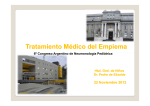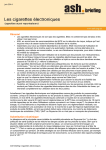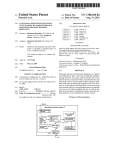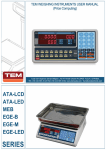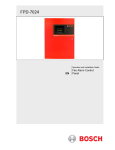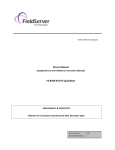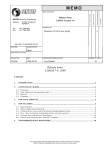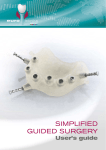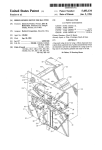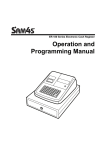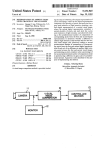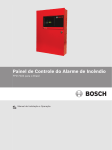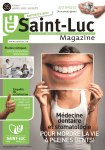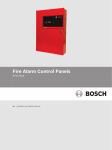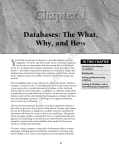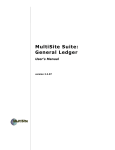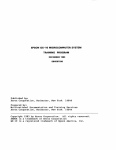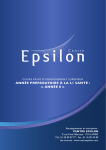Download Automatic invocation of computational resources without user
Transcript
lllllllllllllllllllllllllllllllllllllllllllllllllllllllllllllllllllllllllll US005546502A United States Patent [191 [11] Patent Number: Hart et a1. [45] Date of Patent: [54] AUTOMATIC INVOCATION OF COMPUTATIONAL RESOURCES WITHOUT USER INTERVENTION [75] Inventors: Peter Hart, Meno Park, Calif.; Jamey Graham, San Jose, Calif. Aug. 13, 1996 Elkin, P. L., et a1., “Closing the Loop on Diagnostic Decision Support Systems,” 14th Annual Symposium on Computer Applications in Medial Care, Standards in Media] Informat ics, Nov. 1990, Washington, DC, pp. 589-593. Morjaria, M. A., et al., “Modular Reliability Upgrade Option for Copiers or Printers,” Xerox Disclosure Journal, vol. 17, No. 4, Jul. l992—Aug. 1992, Stamford, Connecticut, pp. [73] Assignees: Ricoh Company, Ltd., Tokyo, Japan; Ricoh Corporation, Menlo Park, Calif. [21] Appl. No.: 34,458 [22] Filed: Mar. 19, 1993 [51] 5,546,502 231—233. Primary Examiner—Allen R. MacDonald Assistant Examiner—Richernond Dorvil Int. Cl.6 .................................................... .. G06F 17/20 Attorney, Agent, or Firm—Townscnd and Townsend and Crew 395/12; 395/50 Field of Search ................................ .. 395/60, 12, 76, 395/61, 10, 13, 50 [57] ABSTRACT A system is described for automatically invoking computa [56] References Cited tional resources without intervention or request from a user U.S. PATENT DOCUMENTS 4,954,964 5,263,126 9/1990 11/1993 Singh ...................................... .. 395/12 Chang ..................................... .. 395/12 0436459Al 11/1990 2/1992 European Fat. 013'. manuals is provided to a user investigating apparatus having a fault. The user enters symptoms based upon the user’s FORElGN PATENT DOCUMENTS WO92/0288O of the system. In the system a query-free information retrieval system is described in which the exact technical documentation contained in existing user or other technical G06F 9/44 WIPO ............................. .. G06F 9/44 OTHER PUBLICATIONS An Information Retrieval Approach For Automatically Con analysis of the apparatus, and in response the system pro vides information concerning likely faults with the appara tus. As the symptoms are entered, the relative value of individual faults is determined and related to the symptoms they cause. The user can then select technical information relating to probable faults in the system. tructing Software Libraries. Maarek et 21 IEEE Aug. 1991. GAMEES II: An Environment For Building Probabilistic Export Sys Based on Arrays of Bayesian Belief Networks Bellazzi et a]. l4—l7 Jun. 1992. 22 Claims, 9 Drawing Sheets BASE COMPUTATIONAL APPLICATION RESOURCE USER INTERACT IONS (CONTEXT) (D RETURNS RELEVANT INFORMATION @ PERFORMS SOME ACTION US. Patent Aug. 13, 1996 Sheet 1 of 9 5,546,502 BASE COMPUTATIONAL APPLICATION RESOURCE USER INTERACTIONS (CONTEXT) () RETURNS RELEVANT INFORMATION C) PERFORMS SOME ACTION FIG. .1 US. Patent Aug. 13, 1996 Sheet 2 0f 9 5,546,502 FUSING TEMP IMAGE RUBS OFF FAULTS SERVICE LIGHT 6 BLADE CLEANER BKGD TEST BLADE BLACK LINES SYMPTOMS FIG. 2 DOTTED LINES 12 US. Patent Aug. 13, 1996 FUSING Sheet 3 0f 9 5,546,502 22 /18 IARPUNG: The fusing unit is heavy and may be hot; be careful uhen handling the unit. 22 —Renovol 1. Remove the fusing unit knob (1 reverse threaded screw) [A] and the fusing unit cover [B] (3 screws). . 2. Open the top unit and slide the fusing unit all the way out. LII . Remove the oil bottle and the oil bottle plate [C] (2 screws). 4. Grasp §he fusing unit handles (front and rear) [0], and slide/lift out the fusing unit (2 screws toward the front. -Installotion-/ 22 5. Fully extend the occuride rails 6. Align the locating tabs [F] on the rear of the fusing unit with the locating pins [6] on the occuride rails. WARNING: If the following step is not done, the fusing unit can cone may fro: the copier accidentally, possibly causing an injury to the operator. 7. Secure the fusing unit to the accuride rails (2 screws). CAUTION: Ihen installing the fusing unit couer, nuke sure the tab [H] on the inside of the cover lifts up the oil sup stopper will fill and overflow. 3-43 FIG. 3 If not, the sup /20 US. Patent Aug. 13, 1996 Sheet 4 of 9 5,546,502 DEVELOP BELIEF COMPILE COQ‘QEETNE T NETWORK SUPPLY BELIEF [NETWORK INFoRMATIoN RUNTIME DEVELOPMENT lggRRhggiiN ENvIRoNMENT ENvIRoNMENT ENVIRONMENT RETURN USER/ MANUAL INFORMATION / RET§2§EgEM§%5N/ANT FIG. 4 d BEFORE ADDITION OF SYMPTOM S4 P(Fi) o l:1 F5 Fl Fl r11 m FIG. 5 1 AFTER ADDITION OF SYMPTOM S4 P(Fi) APB“ “P119 0.03'— 0 F1 F5 Fl F: F11 FIG. 5 m US. Patent Aug. 13, 1996 Sheet 5 of 9 5,546,502 SUPPORT GROUP A TOPICS sYMPToM A SYMPTOM a TOPICS TOPICS SYMPTOM c /30 TOPICS TOPIC DATABASE \50 [35 INTERSECT [40 PRIMARY TOPICS [47 FAULT A TOPICS 45\ USER INTERFACE FIG. 7 [42 SECONDARY TOPICS 5,546,502 1 2 AUTOMATIC INVOCATION OF COMPUTATIONAL RESOURCES WITHOUT USER INTERVENTION of bene?t to the user based on the information entered, then the availability of that additional information is made known to the user. If the user desires the additional information, it can be displayed for review. Alternatively, the user can continue with analysis, reserving a review of the additional information for later. Preferably, in our system a belief network is employed to enable probabilistic or other deter minations to be made of the likely importance of the information available. BACKGROUND OF THE INVENTION This invention relates to expert systems, and in particular to a system in which computational resources are invoked by a user without direct intervention. In a preferred system, according to our invention we The increasing use of expert systems as diagnostic tools in service industries has established that knowledge embed ded systems can provide quality expertise within de?ned domains. Most prior systems, however, do not appreciate the employ an information retrieval method which, unlike prior systems, uses the exact technical documentation contained in the existing user or other technical manuals. It does not require the user to know of the existence of information to usefulness of technical documentation as a resource for receive it. Furthermore, our system does not simply oil’er on-line access to help text, but instead provides contextual pointers (based on the context of the expert system) to the human experts when performing diagnostic tasks. On-Iine technical manuals can aid the user by greatly enhancing the potential for success. Typical prior art systems which do user manual documentation. Whereas most on-line informa tion access systems require the user to enter a search query recognize this asset simply provide interfaces for browsing on-line documentation in a “help text” format. This docu 20 and request processing of that query when searching for mentation, however, is usually the result of experts and developers rewriting, in an abbreviated form, the content of relevant information, our system does not. The availability technical manuals. The exact technical documentation con free” as the user works on a diagnostic problem. This is of relevant information is provided automatically or “query tained in the manuals, and used by most technicians in the ?eld, is not provided. By rewriting the documentation, the experts and developers increase the time to develop a system, and decrease the original content. Because the documentation does not rely on the actual manuals, which are maintained independently, the life cycle costs of main taining this “help text” documentation is high. Some help systems have relied on expert systems to add “intelligence” to the help system. One such prior art system is described in U.S. Pat. No 5,103,498, entitled “Intelligent Help System.” In that system a monitoring device “watches” the system-user interface and determines what monitoring achieved by evaluating the context of the diagnostic session 25 and automatically accessing the appropriate technical docu mentation. No time is lost by the user having to stop to search for relevant documentation; the documentation is simply waiting to be used. Additionally, the text provided when it is requested is that of the user manuals—text with 30 which the user is already familiar. Any updates to the hard copy documentation can be electronically uploaded into our system, so the hard copy and electronic copy of the manual are always consistent. The actual search and retrieval pro cess does not introduce delays because it is performed 35 off-line, during development, before the user ever uses the information to store. This information, together with the physical state of the system, is stored in a knowledge base. system. In a preferred embodiment, an information retrieval sys tem which employs our invention includes a computing An inference engine tests rules against the knowledge base data to generate help text. Unfortunately, in this system the system in which is stored documentation relating to the apparatus to be investigated as well as probabilistic infor mation relating individual symptoms to faults in the appa ratus which may cause such symptoms. The user of the system employs some means of data entry, typically a user must request help, and that help is supplied as help text. A system applied speci?cally to the medical information ?eld provided a method of automatic information retrieval by evaluating the observed manifestations and possible diagnosis. It then provided access to relevant medical texts. keyboard to select from a menu on a screen, to allow the user The system is described in P. L. Elkin, et al., “Closing the 45 to enter symptoms concerning the apparatus being investi Loop on Diagnostic Decision Support Systems," l4th gated. In response, the system calculates probabilities of the Annual Symposium on Computer Applns. in Medical Care, Standards in Medical Informatics, Washington, DC. (November 1990), IEEE Computer Soc. Press. Unfortu individual faults as indicated by the symptoms they cause. The possible faults are displayed, and the user is given an opportunity to select documentation related to the possible faults. nately, the technical details of the system are still unclear. 50 Furthermore, in many prior art systems computational BRIEF DESCRIPTION OF THE DRAWINGS resources typically were, in a sense, turned “on" and “011" by the user. By this we mean that the user decided when to process particular information to determine interrelation ships among all of the entered information, In such systems users are unaware of all of the capabilities of the system and thus often overlook valuable computational resources. SUMMARY OF THE INVENTION 60 We have developed a system which automatically invokes ?gure the computer system for the system described herein; FIG. Sis a graph illustrate the probability of various faults external computational resources without user intervention. In our system a base application, typically a computer program, is used interactively by an individual. As use progresses, a variety of internal calculations are performed based upon information entered by the user. When these calculations determine that additional information could be FIG. 1 is a diagram representing the relationship of a computational resource and a base application; FIG. 2 is a chart illustrating a sample belief network which interrelates faults and symptoms in a system; FIG. 3 illustrates typical user manual documentation, for example, for removal of a fusing unit in a photocopier; FIG. 4 illustrates the method employed to initially con with the apparatus being investigated before introduction of 65 a new symptom; FIG. 6 is a chart illustrating the change in probabilities after introduction of a new symptom; 5,546,502 3 4 FIG. 7 is a ?ow chart illustrating the relationship of information retrieval system. The software we use in the primary and secondary topics; preferred embodiment to achieve this relationship is known as DXpress and is commercially available from Knowledge FIG. 8 is a chart depicting the process of determining support groups and a top contenders list; FIG. 9 is a drawing illustrating a typical user interface; FIG. 10 is a drawing illustrating the selection of primary or secondary information; and FIG. 11 is a drawing illustrating the display of on-line technical information. Industries, Palo Alto, Calif. Although here we use the terms “fault" and “symptom,” it should be understood they are used solely for explanation. Other equivalent terminology may be readily employed, for 10 example, condition and manifestation, state of nature and observation, etc. The use of fault and symptom is particu larly convenient because in the preferred embodiment our system is used by repair technicians to diagnose and repair apparatus. FIG. 2 is a diagram illustrating a typical relationship of faults and symptoms. For illustration, the faults and symp DESCRIPTION OF THE SPECIFIC EMBODIMENTS FIG. 1 is a diagram representing the relationship between a base application and a computational resource in one toms chosen relate to a photocopier repair/adjustment con embodiment of our system. The base application typically text. such as might be employed in conjunction with the will consist of an application operating on a computer system, for example, an expert system, a belief network, or system of our invention. As shown in FIG. 2, each fault can be related to more than one symptom, and each symptom to more than one fault. For example, the fault of a scratched other computer program. The computational resource typi drum 10 can cause many different symptoms, including dotted lines 12. Dotted lines, however, can also be caused by a faulty pick-off pawl 15. Of course, only a few faults and cally will be an information retrieval system, a database or other possible provider of useful information or a performer of some function. In our system the external computational resources are automatically invoked without speci?c user a few symptoms are shown in FIG. 2. An actual belief network will be much larger than that shown in FIG. 2, often intervention. 25 including hundreds of faults and symptoms interrelated in a Preferably as use of the base application progresses complex arrangement. interactively, internal calculations are made based upon the The structure of FIG. 2 in the larger system is developed input information entered by the user. When these calcula— by discussion between the expert and the software devel tions determine that further information could be of bene?t to the user, then the availability of that further information 30 oper. At that time individual probabilities are assigned to the relationships which exist between each individual symptom is made known. In effect the user interactions have estab and all faults. For example, the expert and software devel lished a context by which the computational resource can oper may decide that when dotted lines 12 occur, there is a return relevant information or perform actions. Because, in one-third probability that it is due to a faulty pick-o?‘ pawl the preferred embodiment, the availability of the informa tion is only made known to the user, as opposed to being 35 15 and a two-thirds probability that it is due to a scratched displayed to him, the user can choose to continue with the drum 10. These probabilistic assessments are used in our analysis or project, reserving a review of the information until later. Preferably, our system functions in the probabilistic information retrieval system to identify faults and symp toms, and provide resulting documentation to system users. During a diagnostic session, the user enters observed symptoms into the expert system, thus making the symp expert system environment known as belief networks. The use of belief networks for assessing one’s belief about a set toms active for the current session. As a result, in a manner of circumstances is a technique which has gained popularity described below, technical documentation pertaining to in the last few years in the ?eld of expert systems. The these symptoms becomes available for the user to browse technique represents an expert’s knowledge by assigning a through. The faults supported by these symptoms, that is, the conditional probability to the relationship between a symp 45 tom and a fault, or more generally between a cause and an effect. In such systems, by evaluating when or how a symptom occurs with respect to all possible faults which can cause it, the expert system can provide a probabilistic assessment of this relationship. For example, if the relation faults which cause these symptoms to occur, also become active when there is enough justi?cation, via the observed symptoms, to promote their individual likelihoods. When this occurs, technical documentation for the individual faults is also made available. 50 By recommending only the technical documentation per ship between the symptom “streaky copy” and the fault “toner clutch failure," is “strong“ then the likelihood (prob ability) is high that this fault is present once this symptom taining to the active symptoms and faults, the system pro faults F, i.e., P (SIIFI, F2, . . . , F“). At runtime, these individual active faults by intersecting the topics from the vides only the most relevant textual information of the current context of the diagnostic session. All other docu is observed. In a belief network environment, experts and mentation is available for the user to browse through, but not developers assign probabilistic values to the relationship 55 recommended by the system. We also provide a method of which exists between each individual symptoms and all offering a more context-speci?c set of documentation for probabilities are inverted using Bayes’ rule to represent a fault with respect to the symptoms it causes, e.g., P (F,|s,, supporting symptoms (i.e., the symptoms which have helped symptoms, the relative value of the individual faults which increase an individual fault‘s likelihood) and the fault. The result is a set of topics more speci?c in their depiction of the current diagnosis. are supported by these symptoms goes up, eliminating irrelevant faults from the overall diagnosis. time, we are able to use the content of the network to locate S2, . . . , S"). Thus, as a user observes and enters known 60 The structure of the belief network in our system is represented by symptoms or observed features connected to By exploiting the belief network system at development the faults or hypotheses which cause them. These network relevant documentation to be offered at runtime. At runtime, we take advantage of the active nodes and their alliances to provide more relevant documentation at the appropriate nodes (both symptoms and faults) provide the content for the stages during a diagnostic session. 65 5,546,502 5 6 Although other methods can be used, we retrieve the appropriate information based on the user manual table of contents method. This method is described in detail in relevant subsections. Thus, the user is equipped with the appropriate tools for locating and using the on-line technical documentation. As an example of how our system operates in the ?eld, consider how an expert information retrieval system could be used by a photocopier ?eld service technician: A copier technician has connected his laptop computer to a custom commonly assigned copending U.S. patent application Ser. No. 07/988,729, entitled “Method and Apparatus for Seman tic Pattern Matching for Text Retrieval.” The table of contents method has several advantages over comparable systems. First, the table of contents system uses natural er’s copier. The customer has complained of streaky black lines appearing on all copies made recently. The technician loads the copier diagnostics program and starts to enter, by language understanding techniques and a unique method of propagating the context of topics to provide a better search strategy in user manual texts. Second, our system provides selecting from a menu, the known symptoms the copier has displayed. As he enters the ?rst few symptoms, the system noti?es him of the documentation available based upon both the symptoms and the most probable faults. The technician immediately pursues the documentation on the leading fault candidate to determine if there is any additional information the user with a structured set of fundamental manual topics which relate both to the individual concepts active in the expert system and to the combined context of concepts addressing the same diagnostic goal. As a result, the content of the information available is richer and more useful to the user. Lastly, the probabilistic approach provides a natural method of evaluating what is currently important in the system and what observed items support those important which may con?rm or discount this fault. He also views the documentation of an observed symptom knowing that it can be caused by several different faults and not just the leading concepts. Because of this, our system offers a more complete and reliable set of documentation to support the current 20 fault candidate. In effect the user has invoked a query-free information database (a computational resource) without diagnosis. directly requesting such. Although other types of natural language understanding systems may seem to be better solutions to interfacing with In the preceding example, the technician is provided with computers, other systems have de?nite limitations which inhibit their overall functionality. Such types of natural an interface to an expert’s knowledge of copiers as well as 25 language understanding technology have not matured enough to be an effective tool in the electronic servicing ?eld where small, inexpensive computers are still a requirement. The table of contents system upon which we rely provides an interface for entering and searching for relevant infor system knows the current context of the diagnoses and simply responds with the appropriate documentation. The concept of providing query-free information retrieval mation in a user manual domain. Of course, although we prefer the table of contents approach, either type of system could be used in accordance with our invention, particularly as the natural language technology advances. Our information retrieval system uses input from the belief network environment. Because the belief network is technical documentation, which supplements the overall capability of the expert system. Furthermore, the documen' tation is provided automatically for the technician, without him having to ask the system for additional information. The in any domain is a favorable solution to dealing with query languages, natural or otherwise, which either fail to fully 35 represent a query goal or fail in their ability to handle complex query statements. Our system provides relevant documentation for the current context without the user generated by experts and developers as they construct indi vidual nodes, our system provides a controlled input scheme where experts and developers (familiar with the technical documentation) create the actual English search patterns. The developers are also responsible for making use of the having to formulate a query and wait for the results. To simplify the process of creating node labels used as search patterns, we take advantage of the structure of the expert table of contents database which consists of all relevant structure of the expert system by providing contextual topics from the user manual, typically depicted by the pointers to relevant user manual information. An expert system typically consists of two major software system which is usually closely related to the documentation used to describe the domain. Thus, we bene?t from the original table of contents of the user manual. The database is then convened, using well known techniques and a natural language understanding system, into a semantically de?ned environments: the development and runtime environments. During development, we extract the belief network infor mation, such as shown in FIG. 2, from the Dxpress devel database, where each topic is in the form of a semantic representation, enabling searching for semantic similarities. opment program and process it through an information retrieval system. The information retrieval system uses the information from within each node to form a pattern for searching user manual documentation. The results of the The benefits of simplifying how our system is used in this environment are several. First, our system eliminates the user having to construct a query and the system having to understand it. Typically, the user of our system never stops to enter a query. The appropriate query has already been constructed and parsed, and the relevant information search are a set of topics which relate to the contents of the 55 retrieved. Second, our system eliminates the parse failures which commonly occur when users attempt to construct queries directly. Our system never has to deal with “novel“ node. FIG. 3 is an example of user manual documentation. As shown in FIG. 3, a typical user manual includes drawings, such as in the upper portion 18 of FIG. 3 and text such as in the lower portion 20 of FIG. 3. The topical information queries because of the control utilized at development time shown in FIG. 3 is used for information retrieval as over how to properly construct an input sequence. Finally, 60 described below. Both the drawings and the descriptive text our system simpli?es the process of matching queries and table of contents topics. Because the system is well de?ned include topics 22. in terms of how topics and queries are parsed and repre structure of the node. This is performed off-line, without time delay to the end-user. Because developers and experts are the only users of the development system, they are responsible for conducting the network maintenance manual Pointers to the topics 22 then are stored as part of the sented, the matching becomes simpler. In addition to furnishing the user with query-free infor mation retrieval, our system provides a method of browsing the user documentation such as the table of contents or 65 searches. The end-user does not have to wait for the system 5,546,502 7 8 to search for relevant topics 22 because the task has been completed before the runtime system is built. This excep— tional characteristic means that there is a minimal runtime take the fault out of contention. For most systems, the neutral reaction is the most typical reaction because of the number of faults and their association with that symptom: the most likely situation is that only a few faults have a signi?cant relationship with an individual symptom. Essen cost associated with having the information retrieval system coexisting with an expert system, which is important because of the complexity of some large knowledge bases. FIG. 4 is a diagram illustrating the overall development of tially, the activation predicate eliminates irrelevant faults by using a threshold value of 0.03 (or other desired value). All our system, and represents the system at a high level. As shown in FIG. 4, the initial step in development of a system according to our invention is the establishment of a belief network. The establishment of this network has been dis faults having a probability of 0.03 or greater are considered top contenders. These contenders are the only faults which will signal the user that documentation is available. Of course, other criteria could readily be used in place of a ?xed threshold. Thus far, we have discussed providing user manual docu mentation for individual nodes, not taking into account cussed above in conjunction with FIG. 2. Once established, the information is transferred to an information retrieval system where relevant topics can be retrieved in the form of user manual information. Once that information is identi?ed, the complete system is compiled to establish all of the relationships among the faults, symptoms, and user manuals. possible relationships in the documentation between fault The resulting runtime environment is then available to a user in the user manual documentation are considered the pri mary objective because an intersection de?nes a richer of this system. After establishing pointers from belief network nodes to and symptom nodes. In fact, the nodes which do “intersect” user manual documentation, our system provides an intel description of the current expert system context~—the con text between that of a diagnostic session in which, for ligent method of presenting the documentation at the appro priate time during a diagnostic session. For instance, if the instance, a symptom and a fault both share a common topic. The user likely will ?nd the content of this information more 20 current expert system context is “Drum Damage,” then we relevant than information describing only individual nodes. do not want the system to recommend documentation on the 25 For example, assume a situation exists where there are “Transfer Corona." The solution to this problem is to evalu four observed symptoms and ?ve top contender faults. The ate what nodes are currently important and only offer their most relevant documentation would be the documentation documentation to the user. This is described below. which connects symptoms and faults, for example, fault-A connected to symptom-2. By de?ning a support structure which depicts the symptoms and their relative support for contender faults, the system determines which symptoms support individual faults. Thus, it can perform a simple set intersection of the topics from each node in the support In the runtime environment, the information found by the information retrieval system is made available differently for the symptoms than for the faults. As symptoms are entered by a user, the documentation found by the information retrieval system is made available to the user on request. For instance, if a user enters a symptom into the system and supplemental documentation is available for this symptom, 35 an icon appears next to the symptom (in the list of observed symptoms) denoting the availability of documentation. The structure and produce a rich set of topics with relations to more than one node. This set is called the primary topic set. We call the set of topics having only a relation to an individual node the secondary topic set. To produce a primary topic set for a top contender fault, user may also request to view the documentation of an unobserved (uninstantiated) symptom. This is done, for instance, in cases where the user requires additional infor mation about a symptom prior to instantiation. it is necessary to de?ne what it means to be a member of a fault’s support group. This is done by the support group predicate (SGP). The support group predicate evaluates each Determining when to provide the supplemental fault member of the top contender set each time a new symptom is observed. This process is very similar to that of taking a documentation is more difficult. Faults in the runtime system are presented as a ranked list based on their individual conditional probabilities given all symptoms observed thus far. Because the top contenders appear at the top of the list, the user is able to distinguish between the real contenders and the low probability faults which have little signi?cance before-and-after snapshot of the entire fault set. The after fault “snapshot“ is compared to the before fault “snapshot” and differences noted by examining which faults were most directly in?uenced by the new observable. In other words, under the current set of circumstances. It is for this reason those faults which had the strongest reactions to the new that our system targets only the top contenders to provide automatic documentation for the faults. We de?ne an activation predicate (AP) by which the system decides whether a fault is part of the “active” set of top contenders. The predicate is designed to locate the observable are determined. The support group predicate is based on a APU matrix. The APl-j matrix represents the difference between the probability of each fault before and after a new symptom was entered. 55 current set of top fault contenders. These contenders can change after each instantiation of new symptoms. In the belief network system, the combined sum of fault probabili ties is always 1.0. Thus, each time a new symptom is recorded, the faults which have a strong relationship with this symptom will increase in likelihood. When their values increase, other fault values decrease so that all fault prob If the difference is signi?cant enough, then there is a correlation between the symptom and the fault (a reaction). The diagram below de?nes APO- and the resulting matrix. The symptoms represented are only those symptoms which 60 are active for the current session. These are the only nodes evaluated when measuring the strength of support, nonsup port or neutrality at each instantiation. abilities continue to sum to 1.0. Each fault can have a positive, negative or neutral reac tion. The positive reaction to the instantiation of a new 65 , S1.) is the set of all active symptoms, and ot;support group threshold is the desired threshold. For F,- in F, our goal is to symptom de?nes support by the symptom for the fault. A negative reaction typically de?nes non-support, but may not P(F,-|S,, . . . , Sj)-P(F,-|S,, . . . , SH). F:(F,, . . . , F,,,) is the set of all active faults. S=(S,, . . . ?nd APl-j where Sj is the latest observed symptom APU= 5,546,502 10 9 Next, the user observes the new symptom 77, for If APij>ot, then ADD Sj to the F,- support group SG,-. example, uneven copy density, termed symptom S6. The (Preferably, we set ot=0.0l.) instantiation 79 of this new symptom is added to the list of observed symptoms 74 and transferred to the activation A11, Matrix Observed Symptoms predicate 80. The activation predicate 80 maintains the sI‘S27"‘ISj contender list 81 of the most likely faults to cause the observed symptoms. It also provides an “after“ snapshot 82 of all fault values. These values are used by the support group predicate 85 to maintain contender support groups 86 and to intersect the topics 88 within each support group thereby to make primary and secondary documentation 89 F1 F2 Faults ’ . . AP, available through the user interface. Fm FIG. 9 is a diagram depicting a preferred embodiment of the user interface of our system. The user interface, in this FIG. 5 is a graph which illustrates the individual prob» embodiment, includes three windows 90, 91 and 92, one 90 relating to categories of possible ?ndings by the user, one 91 relating to the user’s observations, and one 92 listing the leading fault candidates based upon the probabilities estab lished in the belief network. The ?rst window represents the abilities of a series of faults based upon a set of symptoms entered into our system at a given time. Note that the sum of the probabilities of all faults must be 1.0. At the instant of the graph in FIG. 5, faults FE and F1] are the top two contending faults as being likely to have caused the symp 20 symptoms available in this category for the user to select. toms entered into the system up to that time. FIG. 6 illustrates what occurs after an additional symptom The middle window 91 represents the observed symptoms. S4 is entered into the system. The addition of symptom S4 probabilities based on all symptoms entered. Also provided In the last window 92 is the list of faults and their current increases the probabilities of F8 and F11 while decreasing the probabilities of all other faults, yet retaining a sum of 1.0. This represents an example of how the APij (snapshot) are a series of graphical “push buttons” 94 to enable the user 25 tive information is available, that fact is indicated by an icon method evaluates the results of introduction of a new 95 which the user may select. FIG. 10 depicts a situation where the user has asked, for symptom. Notice the increase in probability in faults F8 and F“. As their value increases, the value of the other, less relevant, faults decreases. The AP,’- represents the gap between the previous fault probability value and the value after S4 has been observed. If it is decided that a fault has been influenced (either positively or negatively) by the new symptom, then the symptom becomes a member of the fault’s support group. After each new symptom instantiation, all modi?ed support groups are evaluated, producing a new set of primary topics 30 35 mentation based on a speci?c content. From there, the user with respect to primary and secondary topics. As shown in FIG. 7, symptoms A, B and C have been entered 30. These symptoms have been entered through the user interface in a manner which is described below. The symptoms, for the We have discussed an information retrieval system which 45 result, the symptoms intersect 35 to establish primary topics 40 which are likely of most interest to the user. Where the symptoms do not so relate to each other as being within a given fault support group, secondary topics 42 occur which 50 are less well~focused than the primary topics but are still of interest to the user, and are available to the user. In response to this information, the user may employ the user interface 45 to select documentation on the primary or secondary fault A topics 47 available from the topic database 50. FIG. 8 is a diagram illustrating how both the activation predicate and the support group predicate ?t into the existing runtime environment to provide automatic documentation 55 system nodes, which in turn become search patterns. thus increasing the likelihood of retrieval success. Furthermore, the actual computationally intensive task of searching on line text is eliminated from the runtime system by perform ing the action off-line, during development time. These characteristics, which provide simple solutions yet exhibit high quality results, provide an improved system for infor “before” snapshot 71 is presented of all fault values prior to the entry of the newest symptom 72. In the case of FIG. 8, mation retrieval. the previous symptoms 74 consist of symptoms Sl through for these symptoms is presented in the manner described above. operates in parallel with a probabilistic expert system, providing query-free technical documentation as an “auto matic" side-effect of a diagnostic session. The system derives its search goals from the information embedded in the expert system. Thus, our system takes advantage of an expert's knowledge in two ways: as the primary source for constructing a knowledge base, and as a provider of con textually sensitive node labels which can later be used to search technical documentation. As experts become more and more familiar with the documentation and its creation, particularly if standard methods of expression are used, the experts can provide better descriptive labels for the expert recommendations. In FIG. 8, the dark arrows represent flow and the open arrows represent output from the system. The ?gure illustrates how through the user interface 70 a S5 which have been observed. The probabilistic information example, by “clicking“ on the box marked text, to view the documentation for the Pick-off Pawl fault. As shown, the user is presented with lists of both the primary and second ary topics. Once the user has decided which topic to view (e.g., “Pick-off Pawl Replacement”), the user interface pro vides a way of browsing from this point of contact. That is, the relevant topic is simply an entry point into the docu typically will browse in the surrounding textual or illustra tive areas searching for key information. (Typical documen tation is shown in FIG. 3.) FIG. 11 illustrates the user interface provided for the user to actively browse through the documentation once a point of entry is established. for the user to view in the manner explained below. FIG. 7 is a chart displaying the operation of our system sake of this example, are members of a particular fault’s support group (fault A), in the sense of being related to each other as described in conjunction with FIGS. 5 and 6. As a to select other menus or screens where textural or descrip 65 The above description of the preferred embodiment has been made to explain the invention. Although particular examples such as repair of a photocopy machine have been 5,546,502 11 12 described, it should be appreciated these examples are only for illustration and explanation. The scope of the invention is de?ned by the following claims. 12. The method of claim 8 wherein operating the base application comprises operating an expert system. We claim: 1. A system for dynamically invoking a computational 5 resource for a user comprising: 14. The method of claim 12 wherein said computational resource comprises an information retrieval system and said means for operating for the user a base application such that the computational resource is external to the base step of executing the instruction comprises retrieving an indication of availability of information. application; 15. The method of claim 14 wherein: means for receiving into the base application a series of said step of receiving a series of user interactions com user interactions which establish a context; and means for in response to the series of user interactions prises receiving entries of symptoms about a condition; and said retrieved indication of availability refers to informa tion about the condition. 16. The method of claim 15 wherein the expert system includes probabilistic information relating to individual dynamically instructing, responsive to the context, the computational resource to perform selected computa tional operations. 2. A system as in claim 1 wherein the computational resource comprises a computing system having an informa tion retrieval system. 3. A system as in claim 2 wherein the computational resource further comprises a database system. 4. A system as in claim 1 wherein the means for operating for the user a base application comprises an expert system. 5. A system as in claim 4 wherein the expert system further comprises a belief network. 6. A system as in claim 1 wherein the means for receiving into the base application a series of user interactions which 13. The method of claim 12 wherein operating the base application further comprises operating a belief network. symptoms to the condition which causes those symptoms; and wherein said step of executing the instruction further 20 comprises retrieving documentation about the condition. 17. In a data processing system, a method for accessing information comprising the steps of: operating a base application that receives a sequence of 25 user inputs; operating a computational resource external to the base application; establish a context comprises a data entry device. monitoring the context de?ned by the sequence of user 7. A system as in claim 1 wherein the means for instruct ing the computational resource in response to the series of user interactions comprises means for displaying the avail inputs to the base application; dynamically constructing a query to the computational resource responsive to the context; ability of information to the user. searching with the computational resource, using the 8. In a data processing system, a method for dynamically query, for information relevant to the context; and generating a result responsive to a series of user interactions displaying information discovered in said searching step. 18. A method for dynamically invoking a computational comprising the steps of: operating a base application and a computational resource external to the base application; receiving, using the base application, the series of user resource for a user comprising: operating a base application external to the computational resource; interactions; receiving into the base application a series of user inter actions which establish a context; and dynamically instructing in response to the series of user monitoring a context de?ned by the series of user inter actions; dynamically constructing an instruction to the computa interactions, responsive to the context, the computa tional resource to perform selected computational tional resource responsive to the context; executing, using the computational resource, the instruc tion to generate a result; and 45 operations. 19. A method as in claim 18 wherein said dynamically displaying the result. instructing step comprises instructing a computing system 9. The method of claim 8 wherein said computational having an information retrieval system. resource comprises an information retrieval system and said 20. A method as in claim 18 wherein said dynamically step of executing the instruction comprises retrieving an 5o instructing step comprises instructing a database system. indication of die availability of information. 21. A method as in claim 18 wherein said operating step 10. The method of claim 9 wherein said step of dynami comprises operating an expert system operating on the cally constructing an instruction comprises formulating a computing system. query responsive to the context. 11. The method of claim 8 wherein said computational resource comprises a database system and said step of executing the instruction comprises accessing a database. 55 22. A method as in claim 21 wherein said operating step further comprises operating a belief network. * * * * *
















